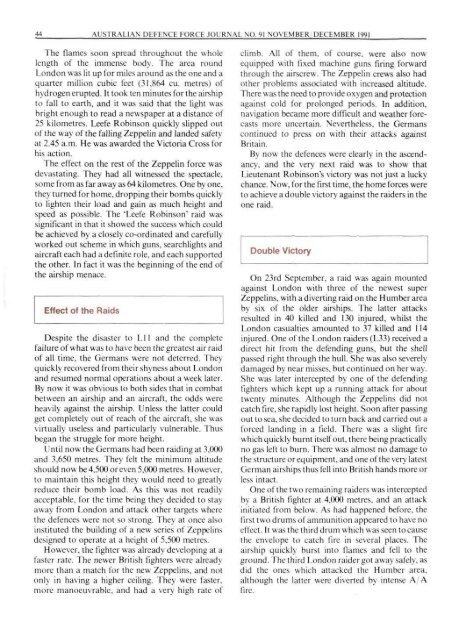ISSUE 91 : Nov/Dec - 1991 - Australian Defence Force Journal
ISSUE 91 : Nov/Dec - 1991 - Australian Defence Force Journal
ISSUE 91 : Nov/Dec - 1991 - Australian Defence Force Journal
Create successful ePaper yourself
Turn your PDF publications into a flip-book with our unique Google optimized e-Paper software.
44 AUSTRALIAN DEFENCE FORCE JOURNAL NO. <strong>91</strong> NOVEMBER DECEMBER 19<strong>91</strong><br />
The flames soon spread throughout the whole<br />
length of the immense body. The area round<br />
London was lit up for miles around as the one and a<br />
quarter million cubic feet (31,864 cu. metres) of<br />
hydrogen erupted. It took ten minutes for the airship<br />
to fall to earth, and it was said that the light was<br />
bright enough to read a newspaper at a distance of<br />
25 kilometres. Leefe Robinson quickly slipped out<br />
of the way of the falling Zeppelin and landed safety<br />
at 2.45 a.m. He was awarded the Victoria Cross for<br />
his action.<br />
The effect on the rest of the Zeppelin force was<br />
devastating. They had all witnessed the spectacle,<br />
some from as far away as 64 kilometres. One by one.<br />
they turned for home, dropping their bombs quickly<br />
to lighten their load and gain as much height and<br />
speed as possible. The 'Leefe Robinson' raid was<br />
significant in that it showed the success which could<br />
be achieved by a closely co-ordinated and carefully<br />
worked out scheme in which guns, searchlights and<br />
aircraft each had a definite role, and each supported<br />
the other. In fact it was the beginning of the end of<br />
the airship menace.<br />
Effect of the Raids<br />
Despite the disaster to Lll and the complete<br />
failure of what was to have been the greatest air raid<br />
of all time, the Germans were not deterred. They<br />
quickly recovered from their shyness about London<br />
and resumed normal operations about a week later.<br />
By now it was obvious to both sides that in combat<br />
between an airship and an aircraft, the odds were<br />
heavily against the airship. Unless the latter could<br />
get completely out of reach of the aircraft, she was<br />
virtually useless and particularly vulnerable. Thus<br />
began the struggle for more height.<br />
Until now the Germans had been raiding at 3.000<br />
and 3,650 metres. They felt the minimum altitude<br />
should now be 4.500 or even 5,000 metres. However,<br />
to maintain this height they would need to greatly<br />
reduce their bomb load. As this was not readily<br />
acceptable, for the time being they decided to stay<br />
away from London and attack other targets where<br />
the defences were not so strong. They at once also<br />
instituted the building of a new series of Zeppelins<br />
designed to operate at a height of 5.500 metres.<br />
However, the fighter was already developing at a<br />
faster rate. The newer British fighters were already<br />
more than a match for the new Zeppelins, and not<br />
only in having a higher ceiling. They were faster.<br />
more manoeuvrable, and had a very high rate of<br />
climb. All of them, of course, were also now<br />
equipped with fixed machine guns firing forward<br />
through the airscrew. The Zeppelin crews also had<br />
other problems associated with increased altitude.<br />
There was the need to provide oxygen and protection<br />
against cold for prolonged periods. In addition,<br />
navigation became more difficult and weather forecasts<br />
more uncertain. Nevertheless, the Germans<br />
continued to press on with their attacks against<br />
Britain.<br />
By now the defences were clearly in the ascendancy,<br />
and the very next raid was to show that<br />
Lieutenant Robinson's victory was not just a lucky<br />
chance. Now, for the first time, the home forces were<br />
to achieve a double victory against the raiders in the<br />
one raid.<br />
Double Victory<br />
On 23rd September, a raid was again mounted<br />
against London with three of the newest super<br />
Zeppelins, with a diverting raid on the Humber area<br />
by six of the older airships. The latter attacks<br />
resulted in 40 killed and 130 injured, whilst the<br />
London casualties amounted to 37 killed and 114<br />
injured. One of the London raiders (L33) received a<br />
direct hit from the defending guns, but the shell<br />
passed right through the hull. She was also severely<br />
damaged by near misses, but continued on her way.<br />
She was later intercepted by one of the defending<br />
fighters which kept up a running attack for about<br />
twenty minutes. Although the Zeppelins did not<br />
catch fire, she rapidly lost height. Soon after passing<br />
out to sea, she decided to turn back and carried out a<br />
forced landing in a field. There was a slight fire<br />
which quickly burnt itself out, there being practically<br />
no gas left to burn. There was almost no damage to<br />
the structure or equipment, and one of the very latest<br />
Cierman airships thus fell into British hands more or<br />
less intact.<br />
One of the two remaining raiders was intercepted<br />
by a British fighter at 4,000 metres, and an attack<br />
initiated from below. As had happened before, the<br />
first two drums of ammunition appeared to have no<br />
effect. It was the third drum which was seen to cause<br />
the envelope to catch fire in several places. The<br />
airship quickly burst into flames and fell to the<br />
ground. The third London raider got away safely, as<br />
did the ones which attacked the Humber area,<br />
although the latter were diverted by intense A A<br />
fire.

















